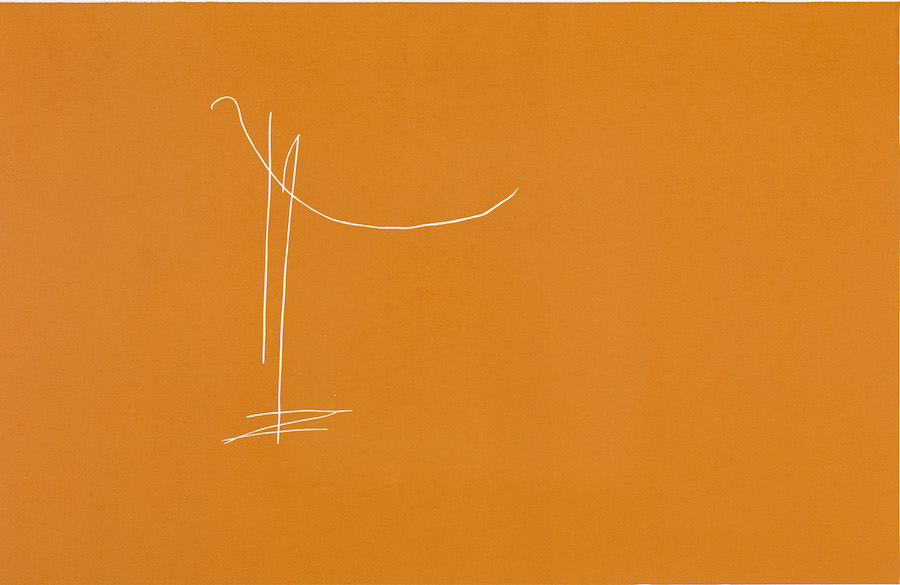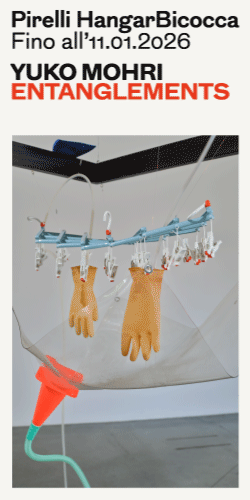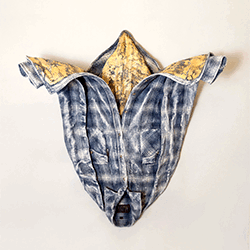
English interview below
Ha inaugurato ad ottobre alla Collezione Maramotti la mostra personale di Helen Cammock, vincitrice della settima edizione del Max Mara Art Prize for Women e nominata al Turner Prize 2019.
Risultato di una residenza italiana di sei mesi svolta dall’artista nel 2018, Che si può fare porta negli spazi della Collezione una pratica artistica multimediale che abbraccia testo, fotografia, video, canzone, performance e incisione, tecniche e linguaggi diversi che mettono in discussione le narrative storiche tradizionali sull’identità. Attingendo alla sua esperienza personale e alla storia, la Cammock mette in luce una concezione circolare della storia creando un dialogo tra forme e contenuti, tra passato e presente. Ad unire luoghi, storie e tempi, è il lamento legato alla perdita, al desiderio, ma anche alla resilienza e resistenza. Il titolo stesso della mostra riprende quello di un lamento preoperistico del 1664 della compositrice italiana Barbara Strozzi, figura fondamentale per lo sviluppo della musica italiana, famosa tra i suoi contemporanei e in seguito per secoli dimenticata.
Il lamento diventa così strumento di riscoperta di voci femminili nascoste che si intersecano attraverso lo spazio e il tempo nel video a tre canali che costituisce l’opera centrale della mostra. Le testimonianze di attiviste nel sociale, di migranti, di rifugiate, di una suora e di donne che hanno combattuto la dittatura, si alternano intercalate con brani musicali e filmati girati in Italia. Il risultato è un complesso collage visivo e orale, che rievoca il potere delle voci femminili dall’epoca Barocca all’Italia di oggi.
Insieme ad esso compongono il progetto una serie di incisioni su vinile nelle quali musica e voce si incontrano, un fregio serigrafato e una stanza di ricerca in cui sono esposti libri e oggetti raccolti dalla Cammock e a lei donati in Italia tra Bologna, Firenze, Venezia, Roma, Palermo e Reggio Emilia. Un viaggio durante il quale musiciste, storiche, artiste e cantanti hanno aperto i loro archivi e condiviso narrazioni con le quali l’artista ha creato ponti e connessioni, facendo riferimento a storie di oppressione e resistenza, incorporando influenze provenienti da jazz, blues, poesia e danza. Dalle immagini e dai testi, dalle storie raccontante e dalle testimonianze, quello che emerge è una complessità di voci che la Cammock non solo registra in quanto testimonianze, ma che mescola a comporre una narrazione corale per rivelare e sfidare quelle strutture di potere che soggiogano e marginalizzazione individui e comunità.


Guendalina Piselli: Che si può fare is the title of your exhibition at Collezione Maramotti. It is the result of a six-month journey in Italy. How the project was born? Did these six months of travelling made any changes in some way on your initial idea?
Helen Cammock: The prize awards a six month residency in Italy and I moved between Bologna, Florence, Venice, Rome, Palermo and Reggio Emilia, setting out to explore the expression of lament through the female voice. I had the opportunity to engage with many of the things I’d hoped but also the unexpected. Towards the end of the residency I spoke to a woman at the airport and was explaining what I was doing – a six month residency around Italy – and she said ‘oh I’d love to have a six month holiday’ and i said ‘no actually I’ve worked really hard and its been amazing’ and she said ‘yes – i work really hard too but I don’t get six months off’. So I think its hard for people to imagine what the six months were like – I didn’t have weekends, I travelled around and met often two or three different people, projects, institutions in a day, I was welcomed and hosted by so many amazing people, archives and projects that my mind is still spinning. I filmed from a kayak around the Venetian lagoon; I interviewed a 92 year old ex-partisan fighter and an experimental opera singer; I visited a project where women who have stories to process, do it through making story bags; And I filmed a contemporary dancer who hadn’t danced for twenty years, but who works with adults and children to enable them to make sense of the relationship between their mind and body. I invited her to choreograph and perform her own piece for the project to camera and she did. I had classical singing lessons to help me to perform the Barbara Strozzi pre opera lament Che Si Può Fare in duet with a jazz trumpeter. And I made an etched artist book in Rome – a print process that I had never worked with before. So my experience was enriching, humbling, informative and challenging and yes has definitely marked my life – not just creatively and professionally but also personally. The work then has been formed by my experience. So the overall shape of the project – formally and as well as through its content – resembles something of what I envisioned. What I’ve produced is relational – a chorus of human interconnections, transposition of and having of sounds, the images folding into different histories and understandings – broadly an attempt to create an experiential space that positions itself at times at the limit of vocabulary, where sound and what is even beyond the frame take over.


GP: Che si può fare is also the title of a baroque lament composed by Barbara Strozzi, a crucial figure for music history and almost forgotten such as Francesca Caccini. During the opening you sang her composition, for the first time not a piece of yours, creating in this way a sort of temporal link between XII century and the present. Could it be considered a work based on the archive such as your previous works There’s a Hole in The Sky I and The Long Note?
HC: Absolutely – there is something about going back for voices and stories…and the physical embodiment of this is something that runs throughout my practice. So making links between my own sense of lament and a woman who lived hundreds of years before me, epitomises the kind of haptic relationship that is present in most of my works. It’s about a kind of time travel between past and present (and of course future) but also this idea that we can cross cultural and geographical boundaries if we are open to them or allow ourselves to be touched by them.
GP: This is a work about lament, concept traditionally associated to women in a negative way. It is true that the lament is something personal but sharing it means opening to the others, creating a collective moment. It doesn’t sound so badly but as a possibility of a new scenario…
HC: Yes – In Chorus I and in the prints, frieze (Chorus II) and performance that accompany, I set out to explore the idea of lament, as I’ve said through researching women’s live. For me lament is about loss, longing, but also very much about resilience and resistance. I am interested in revealing, unpicking, challenging structures of power that subjugate and marginalise certain individuals and communities. This film is about the female voice – women have had to manage the oppression of patriarchy for centuries and therefore when we speak about the struggle of power around gender we are addressing patriarchy. But in this film we are also talking about the strength of women; the ways that women have shaped, protected, contributed to, stood their ground in moments of crisis but have been written out of histories or ignored or intentionally silenced. I want the work to enable an active listening – whether they are voices from today or the voices from six centuries ago – to be able to acknowledge what you have lost or long for is in itself an act of strength – it recognises an emotional literacy – and then to do something with this loss is what resilience is all about. It can be used to fight oppression or to hold communities together – it can be used to survive the death of a child or even a whole family. I am in awe of the capacity we have to survive and emerge from trauma.
GP: Che si può fare is not only an artistic but also a social reflection as it’s dealing with themes such as woman condition, the weight of history and immigration, told through the lament. Am I too optimistic saying that the feeling at the end of this exhibition is that there is a possibility? A hope?
HC: Yes whenever you take the time to look back and see the foundation of strength that has come before you – and when you listen to the voices that speak of their drive to work not just for their own agency but also the agency and freedom of others – the disappointments and losses but also the visions of contemporary women mean the future is important. When you look at the world with the idea that you want to continue to change it – it is because you care about it. And with care, there is always hope.


GP: Your art includes texts, photography, video, performance and print, exploring the space and the relationship between text and image – I have the impression that it happens in the catalogue of the exhibition as well. Which is the role of the voice in this context?
HC: The catalogue, which I saw as an artists book, contains drawings, photographs film stills, poems, many of which were written specifically for the book and a vinyl recoding of the Che Si Può Fare duet – It is a collage, a chorus of voices pulled into conversation by my own voice – as the teller or poet or drawer. The relationship between the different forms is a kind of riffing across surfaces…probing and creating dialogues across the form as well as the content.
I am interested in the different registers of the voice – and therefore I use spoken, read and sung word – also different forms of the written word as part of my scripts for films and performances. This could be poetry, philosophical text, political text, song lyrics etc. We receive meaning differently depending on what it is but also how it is delivered so I like to play with this across my projects. I’m very interested in what the voice can do – also what is done to the voice.
The catalogue is probably the part of the whole project where my voice takes more of a central position. The texts are mediations on my thoughts and experiences – whether that’s through situations I found myself in, people I met, or through experiences in libraries, archives and museums – but I am very definitely present. And in many of the texts I am reflecting on what others have told me – or what I have seen – or what I felt when looking at a painting or reading something in archive, or have been walking unknown streets – this is very much through my gaze but there are interwoven narratives that take it outside of me to build a sense of the collective.
GP: The voices and the stories you collected during your trip visually converge in the three-screen video installation. The private lament becomes collective, generational and social. Which is here the role of filming?
HC: Most of my projects work across a range of mediums. It depends for me on the project which mediums I use. This offers me different ways to articulate linked or intersecting ideas. It gives scope for narratives, abstractions and a kaleidoscope of the ideas in a range of ways but usually the video is the core element to the project. The relationship between image and text is key in opening up an in-between or liminal space where new meaning can be created. Sometimes there is a juxtapositon between what we see and what we hear and other times the relationship between image and text extends or stretches the meaning. So it not only that I weave multiple voices together to create new meanings it is also the role of the space between the visual imagery and the spoken or sung text.
What I hope for the outcome is a collective chorus..I am sometimes the conduit and other times not but ultimately the chorus crosses private and public, generational, social and historical contexts in its song.
The three-way screen says something about how I began to see the world I found myself in – moving between cities, histories, relationships and encounters. I filmed everything on an iphone and my Canon 5D – and very quickly I began to feel that I wanted to make a work that somehow shared the intersectionality of the conversations across time and place – thread lines of experience, of politics, of oppression, of pain and of strength. And the three-way screen made sense in articulating how interwoven the stories were. We move across frames and outside frames and this way it’s a way of further extending the potential of narrative structures. There is something about the folding in and out of images for me that I am interested in. The idea of the fold is very connected to the Baroque and I am interested in the formal qualities and conceptual potential of it.
GP: In your works past and present seem to meet, to merge, to influence each other. More like a cyclical conception more than linear of history….
HC: We can see the cyclical nature of social patterns and the lines that can be drawn between, across and through history. I almost always move across different periods of time and geographical places and Italy was no different. The stories kept unfolding as I meet new people, cities and archives.
There is no linear narrative arc and you are introduced to women at different stages of the work; they speak from now, from history, referring to the present, or to he past and they merge and weave and diverge and crossover – they are live and so they bounce from one place and moment or community to another. If we can’t look to deeper histories that are constituent of the now – then we’ll have no considered approach for our agency in the future…so these synapses are vital.














